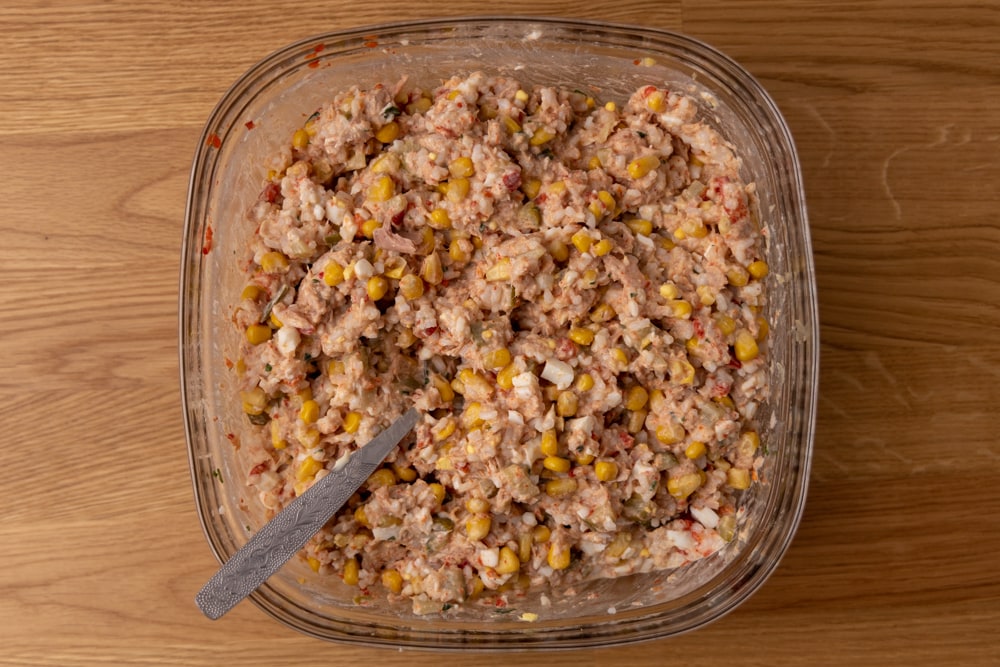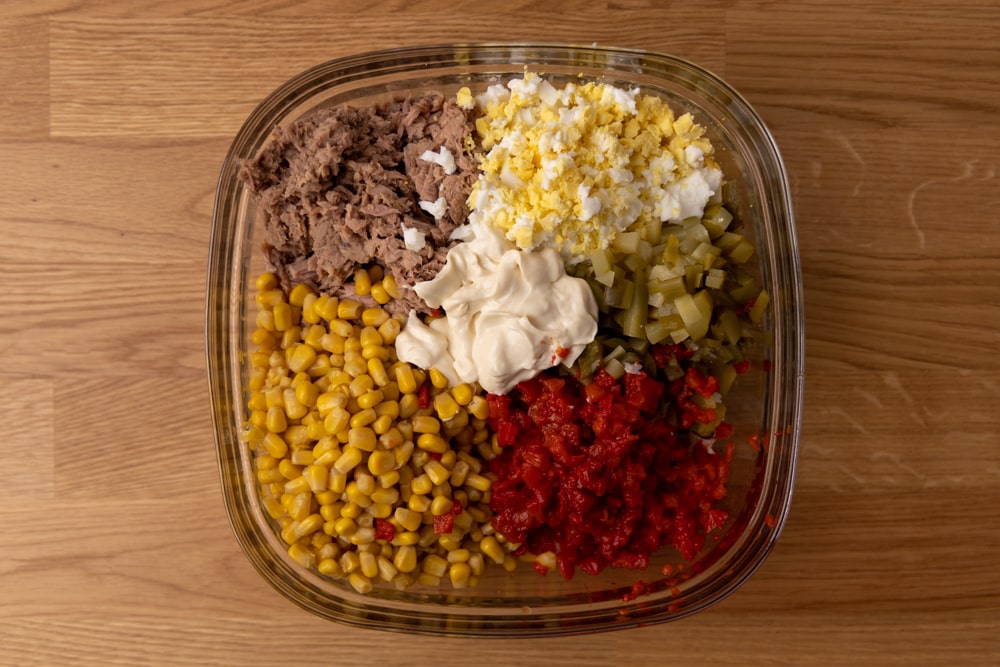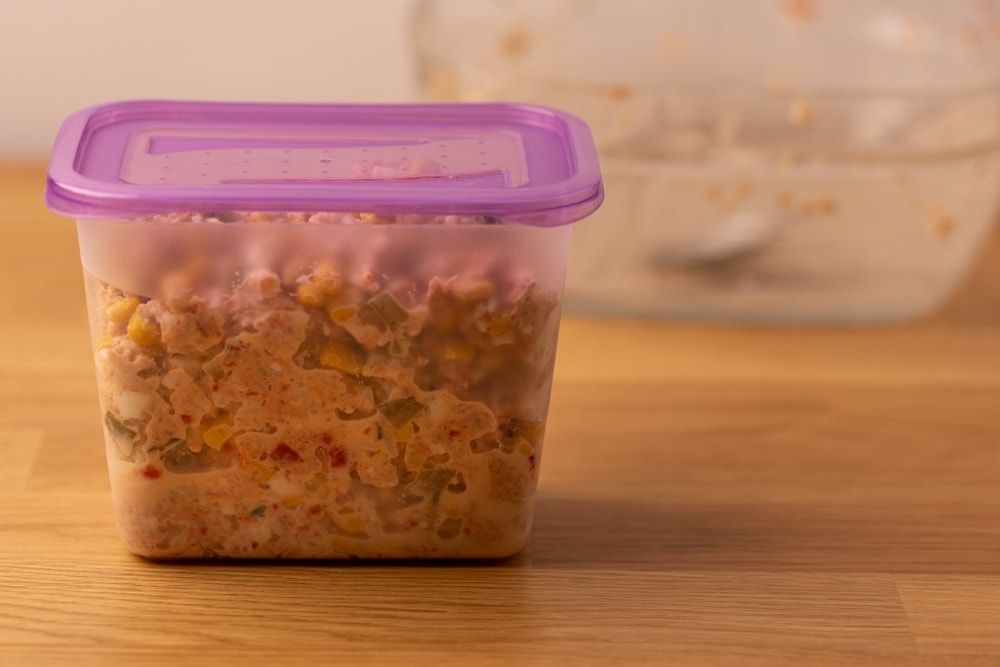How Long Does Tuna Salad Last In The Fridge?
There’s leftover tuna salad in the fridge and you’re thinking how many days it can sit there before it spoils. How long does tuna salad last?
Or you’re thinking about doubling your recipe so that there’s enough food for a couple of days. But before you get your hands dirty, you want to know how that salad will hold up and what’s the best way to store it.
Sounds familiar? If so, this article is for you. In it, we’re going to talk about:
- shelf life and storage practices for tuna salad
- whether or not freezing the leftovers is an option
- telling if your old tuna salad is bad or not
Let’s jump right in.

How Long Does Tuna Salad Last?
You can store your homemade (or store-bought) tuna salad for between 3 to 5 days in the fridge. If it sits for longer than two hours on the counter, it’s not safe to eat anymore, and you should discard it.
That’s what USDA says about storing salads, and that’s what you should run with. Plus, that’s how long does canned tuna last in the fridge after opening.
While tuna salad isn’t safe to eat (i.e., you risk food poisoning) after those 5 days of storage, sometimes you might have to discard it earlier due to quality reasons. It’s all about the ingredients.
If your salad features yogurt or another dairy product that tends to separate, that salad might look (and taste) pretty bad after 2 to 3 days. It works the same way with homemade salad dressings.
But if you use a store-bought dressing such as mayonnaise or ranch, it most likely won’t separate, and that salad should retain quality for the full five days. Assuming that it’s stored properly, of course. More on that later in the article.

If your dressing tends to separate, consider prepping and storing the salad without the dressing – you only add it right before serving. This way, the salad keeps quality for much longer.
Speaking of dressings and separation, you may want to test some dressing alternatives that might yield better results storage-wise. Maybe if you add a different one or a smaller amount, the salad will keep for longer.
If you’re not sure how well your salad keeps, prepare a larger than usual amount and try storing the leftovers for a few days. This way, you’ll learn how quickly it loses quality.
If you store the salad without the dressing, you can try making healthier versions of your usual recipe. For example, you might test if lowering the amount of mayo and adding some yogurt instead works for it or not.
| Fridge | |
|---|---|
| Tuna salad | 3 – 5 days |

How To Store Tuna Salad
Store tuna salad in an airtight container in the fridge, no matter if it’s store-bought or homemade.
If you open your fridge often, put the box with the salad on the back of the shelf. That’s where the temperature is more stable than near the door, and that’s better for your tuna dish.
Next, if you’re not going to finish the salad in one go, always use a clean spoon. Scoop as much as you need, and put the rest in the fridge immediately. In other words, avoid letting your fish salad sit at room temperature.
And if anyone needs extra helpings, you can always grab that container and add more to your plate (or sandwich). Don’t forget about using a clean spoon for that as well.
(The same advice applies to storing other salads, such as storing coleslaw or macaroni salad.)

Can You Freeze Tuna Salad?
It depends on the ingredients of your salad.
Freezing will make crisp veggies go limp and watery, and dairy products separate (check my article on freezing yogurt to see what that looks like). Your dressing might separate as well.
But even if that happens, stirring the salad might be enough for you to enjoy (or at least be okay with) eating it. It’s all about personal preferences.
Because of that, it’s best to do a test drive.
Freeze a single serving in an airtight container for a few days, and see how it goes. It probably won’t taste fabulous, but maybe it will be good enough. Be prepared to discard that salad, though, because chances are it won’t taste that great.
If you really want to make freezing homemade tuna salad work, try freezing it without the dressing and reduce or skip any crisp veggies that your recipe might call for.

How To Tell If Tuna Salad Is Bad?
Throw out your tuna salad if:
- It develops mold or any dark or discolored spots. If things got this far, that tuna salad has gone bad.
- It gives off a sour or funky odor. Give it a good whiff, and if it doesn’t smell right, it’s done for.
- The salad sits in the fridge for more than five days. It’s not necessarily spoiled, but it’s not safe to eat anymore.
- It sits on the counter for more than two hours. After that period, it’s no longer safe to consume.
- The taste is off, or the quality is not up to par. As I mentioned earlier, some ingredients make the salad lose quality rapidly. If yours tastes bad or the texture has changed, there’s no point in forcing yourself to finish it.

Like with other salads (e.g., potato salad, chicken salad), many of the factors above are up to you to judge. For many of you, a slightly watery tuna salad might be okay, but that’s your call.
Related: How Long Does Egg Salad Last in the Fridge?
Related: How Long is Chicken Salad Good For?
If you don’t feel like eating that old salad for any reason, assume that the food is spoiled and discard it. Better safe than sorry.
Rotten Records: Share Your Snap!
Caught some food past its prime? Upload your photo to “Rotten Records” and help others spot the signs of spoilage. Every image makes our food community safer and more informed!


![How Long Does Meatloaf Last? [Storage, Shelf Life, and Spoilage]](https://www.doesitgobad.com/wp-content/uploads/Freshly-baked-meatloaf-768x512.jpg)


